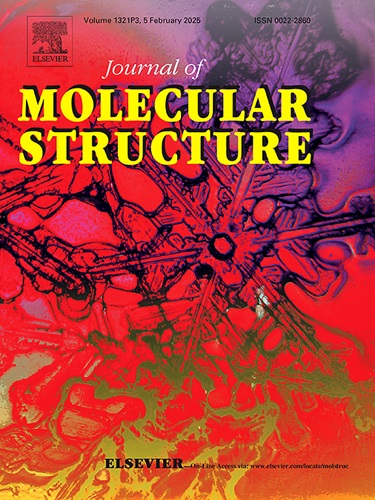Evolution of strong fluorescence from the thiolated nanoclusters for the detection of H2O2 and Ba2+in one pot
IF 4
2区 化学
Q2 CHEMISTRY, PHYSICAL
引用次数: 0
Abstract
A highly fluorescent thiolate-protected AuAg@Na nanocluster (GSS@Na) (based on d-d transitions between discrete energy levels and natural crystallization/confinement) was obtained via a modified hydrothermal technique employing a glowing bulb. The fluorescence was selectively and sensitively quenched by hydrogen peroxide and mammoth enhancement was obtained with exclusively Ba2+. Thus, H2O2 [linear detection range 10–4 M to 10–7 M and limit of detection (LOD) 1.2 × 10–5 M] and Ba2+ (LOD 7.8 × 10–7 M and the linear detection limit10–5 M to 10–8 M) sensing platforms were designed in a single pot. Manipulation of electronic charge redistribution was attributed to be the pivotal factor for turn off/on fluorescence. Furthermore, the protocol was employed on natural samples for prototype applications.

硫代纳米团簇检测H2O2和Ba2+的强荧光演变
通过采用发光灯泡的改进水热技术获得了高荧光硫代酸保护的AuAg@Na纳米团簇(GSS@Na)(基于离散能级和自然结晶/约束之间的d-d跃迁)。双氧水选择性、灵敏地猝灭了荧光,仅Ba2+增强了荧光。因此,我们设计了H2O2(线性检测范围为10-4 M ~ 10-7 M,检出限为1.2 × 10-5 M)和Ba2+(检出限为7.8 × 10-7 M,线性检测限为10-5 M ~ 10-8 M)传感平台。电子电荷再分配的操纵被认为是关闭/打开荧光的关键因素。此外,将该协议应用于自然样本的原型应用。
本文章由计算机程序翻译,如有差异,请以英文原文为准。
求助全文
约1分钟内获得全文
求助全文
来源期刊

Journal of Molecular Structure
化学-物理化学
CiteScore
7.10
自引率
15.80%
发文量
2384
审稿时长
45 days
期刊介绍:
The Journal of Molecular Structure is dedicated to the publication of full-length articles and review papers, providing important new structural information on all types of chemical species including:
• Stable and unstable molecules in all types of environments (vapour, molecular beam, liquid, solution, liquid crystal, solid state, matrix-isolated, surface-absorbed etc.)
• Chemical intermediates
• Molecules in excited states
• Biological molecules
• Polymers.
The methods used may include any combination of spectroscopic and non-spectroscopic techniques, for example:
• Infrared spectroscopy (mid, far, near)
• Raman spectroscopy and non-linear Raman methods (CARS, etc.)
• Electronic absorption spectroscopy
• Optical rotatory dispersion and circular dichroism
• Fluorescence and phosphorescence techniques
• Electron spectroscopies (PES, XPS), EXAFS, etc.
• Microwave spectroscopy
• Electron diffraction
• NMR and ESR spectroscopies
• Mössbauer spectroscopy
• X-ray crystallography
• Charge Density Analyses
• Computational Studies (supplementing experimental methods)
We encourage publications combining theoretical and experimental approaches. The structural insights gained by the studies should be correlated with the properties, activity and/ or reactivity of the molecule under investigation and the relevance of this molecule and its implications should be discussed.
 求助内容:
求助内容: 应助结果提醒方式:
应助结果提醒方式:


